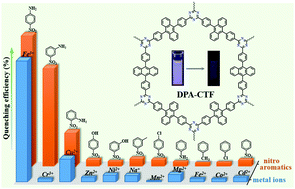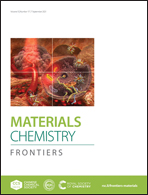An anthracene based conjugated triazine framework as a luminescent probe for selective sensing of p-nitroaniline and Fe(iii) ions†
Abstract
Covalent triazine frameworks (CTFs), as a burgeoning type of porous organic material, have attracted increasing attention in a lot of research fields, including gas separation, heterogeneous catalysis, etc. In particular, stemming from their heteroatom effect (HAE), incorporated with the merits of π-conjugated frameworks, electron-rich triazine units and extraordinary chemical stability, they exhibit prospective potential applications in chemical sensing. In this paper, a triazine-based conjugated porous organic polymer (DPA-CTF) containing anthracene units was used to study the sensing effects on nitroaromatic compounds and metal ions. Intriguingly, DPA-CTF showed sensitive detection performance towards nitroaromatic explosives, especially p-nitroaniline (p-NA). Besides, it also exhibited high sensitivity toward Fe3+ ions compared to other metal ions. A series of characterization studies and computational simulations were used to explain the mechanism of the luminescence quenching effect. These results manifest that the new synthesized CTF is a promising candidate as a chemical sensor for p-NA and Fe3+ ions.

- This article is part of the themed collection: 2021 Materials Chemistry Frontiers HOT articles


 Please wait while we load your content...
Please wait while we load your content...